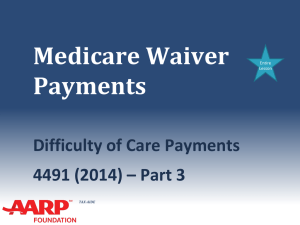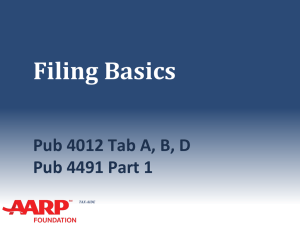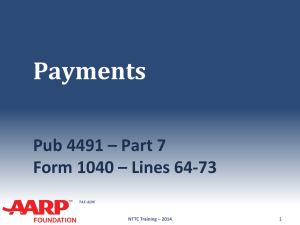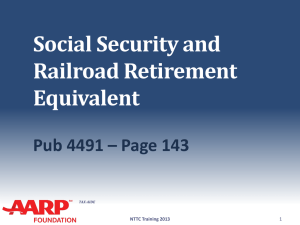07 Filing Status
advertisement
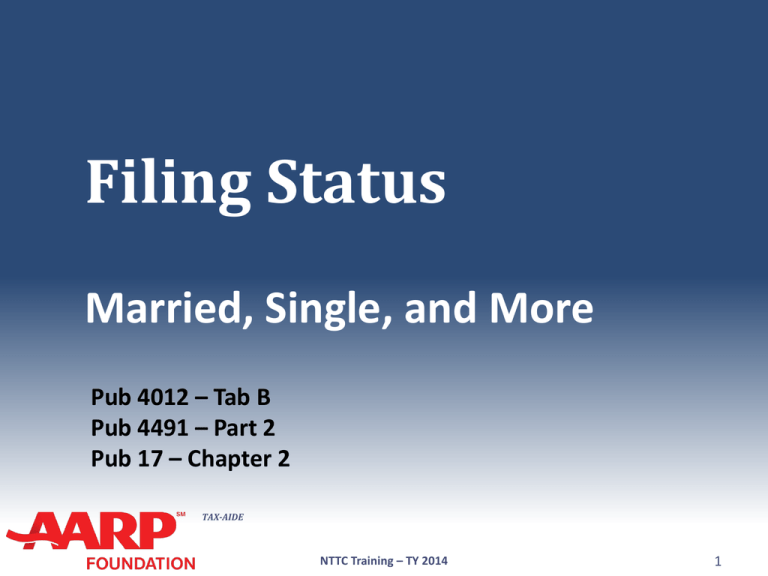
Filing Status Married, Single, and More Pub 4012 – Tab B Pub 4491 – Part 2 Pub 17 – Chapter 2 TAX-AIDE TAX-AIDE NTTC Training – TY 2014 1 Filing Status Pub 17 Ch 2 ● Two criteria: Marital status on last day of tax year Federal definition – “married” ● Legal marriage under laws of any state or country ● Does not include civil unions or registered domestic partners Type of dependents, if any TAX-AIDE NTTC Training – TY 2014 2 Five Choices for Filing Status Pub 4012 Tab B ● Single ● Married filing jointly (MFJ) ● Married filing separately (MFS) ● Head of household (HH) ● Qualified widow(er) (QW) TAX-AIDE NTTC Training – TY 2014 3 Form 1040 TAX-AIDE NTTC Training – TY 2014 4 Form 1040 TAX-AIDE NTTC Training – TY 2014 5 Intake/Interview Sheet Check Part II entries on Intake Sheet Ask questions – verify TAX-AIDE NTTC Training – TY 2014 6 Living Situation Analysis ● Marital status as of 12/31 ● Others living in home, if any Their relationship/dependency Who paid upkeep ● If widow(er) Date of death of spouse Any dependent children at home TAX-AIDE NTTC Training – TY 2014 7 Use the Decision Tree Pub 4012 Page B-1 Don’t miss the footnotes TAX-AIDE NTTC Training – TY 2014 8 Filing Status Importance ● Many tax items affected by filing status Necessity to file a return Standard deduction Tax rate bracket Eligibility for certain credits TAX-AIDE NTTC Training – TY 2014 9 Filing Status – File a Return TAX-AIDE NTTC Training – TY 2014 10 Filing Status – Standard Deduction TAX-AIDE NTTC Training – TY 2014 11 Filing Status – Tax Rate TAX-AIDE NTTC Training – TY 2014 12 Single ● Not married as of December 31st ● Married, but legally separated ● No dependent children at home TAX-AIDE NTTC Training – TY 2014 13 Married Filing Jointly ● Married on last day of year ● Common law marriage If recognized in state where started ● Spouse died during current year/not remarried ● Generally, most advantageous filing status TAX-AIDE NTTC Training – TY 2014 14 Married Filing Separately ● Taxpayer chooses to file MFS ● Spouse has already filed MFS ● Married but separated and not filing MFJ ● Rare cases – more advantageous Generally, no children in home TAX-AIDE NTTC Training – TY 2014 15 MFS Disadvantages ● Highest tax rate/lower standard deduction ● Cannot claim most tax credits ● Cannot deduct student loan interest ● Capital loss limit $1,500 (not $3,000) TAX-AIDE NTTC Training – TY 2014 16 Head of Household – Unmarried ● Provided home for qualified child Might not be a dependent ● Provided home for related dependent ● >50% cost of maintaining home for dependent parents living elsewhere TAX-AIDE NTTC Training – TY 2014 17 Head of Household – Married ● Lived apart all of last 6 months of year ● Provided home for: Child, stepchild, or eligible foster child for over six months ● No other relatives qualify TAX-AIDE NTTC Training – TY 2014 18 Head of Household – Providing a Home Pub 4012 Page B-4 TAX-AIDE NTTC Training – TY 2014 19 Head of Household ● Key advantages Higher standard deduction than Single or MFS Advantageous tax rate structure TAX-AIDE NTTC Training – TY 2014 20 Qualifying Widow(er) ● Spouse died in one of two past years Has dependent child or stepchild in home all year Grandchild not eligible ● Maintained home for child >50% of cost ● Can file QW for two years only TAX-AIDE NTTC Training – TY 2014 21 Qualifying Widow(er) ● Advantages Standard Deduction – same as MFJ Uses MFJ tax rates TAX-AIDE NTTC Training – TY 2014 22 Special Notes ● Child is considered to have lived with taxpayer all year if born or died during year (but not stillborn) ● Child who is dependent of non-custodial parent under Rules for Divorced or Legally Separated Parents still qualifies custodial parent for HH filing status if all other requirements met TAX-AIDE NTTC Training – TY 2014 23 TaxWise – Main Information Sheet Enter name and SSN only if child not also dependent TAX-AIDE NTTC Training – TY 2014 24 Quality Review ● Review prior year’s status ● Verify current year filing status with data on Intake Sheet ● Discuss options with taxpayer Ensure best option selected TAX-AIDE NTTC Training – TY 2014 25 Five Choices for Filing Status Pub 4012 Tab B ● Single ● Married filing jointly (MFJ) ● Married filing separate (MFS) ● Head of household (HH) ● Qualified widow(er) (QW) TAX-AIDE NTTC Training – TY 2014 26 Turn to the Decision Tree Pub 4012 Page B-1 TAX-AIDE NTTC Training – TY 2014 27 Problem #1 ● Mr. Buck provides total support for his two young children. His wife died in 2011, and he has not remarried. ● What is the best filing status for Mr. Buck? Head of Household ● What would have been best in TY2013? Qualifying Widower TAX-AIDE NTTC Training – TY 2014 28 Problem #2 ● Jane, 69, whose husband died July 1, had a $20,000 pension and $15,000 in social security in the tax year. ● Her 10-year-old grandson lived with her and is her dependent. ● What is the best filing status for Jane? MFJ ● Assuming nothing changes, what filing status is best for the following tax years? Head Of Household TAX-AIDE NTTC Training – TY 2014 29 Problem #2 (cont) Note: Grandchild is not a qualifying child dependent for Qualifying Widow(er) with Dependent Child purposes – own child or stepchild only TAX-AIDE NTTC Training – TY 2014 30 Problem #3 ● Luke and Linda are still married, but chose to live apart for most of the year ● Their two children lived with Linda all year ● In July, Luke was out of a job so he moved back in the house for just that month ● What filing status can they each choose? MFJ or MFS (both must use same status) TAX-AIDE NTTC Training – TY 2014 31 Problem #4 ● Dick and Jane are married, lived apart all year, and are filing separate returns. ● Their 25-year-old daughter Jody lived with Jane all year while attending school full-time. ● Jody earned $2,500 during the summer. ● What is Jane’s best filing status? Head of Household ● What would be Jane’s filing status if Jody earned $3,970? Married Filing Separately TAX-AIDE NTTC Training – TY 2014 32 Filing Status Questions? Comments? TAX-AIDE NTTC Training – TY 2014 33
